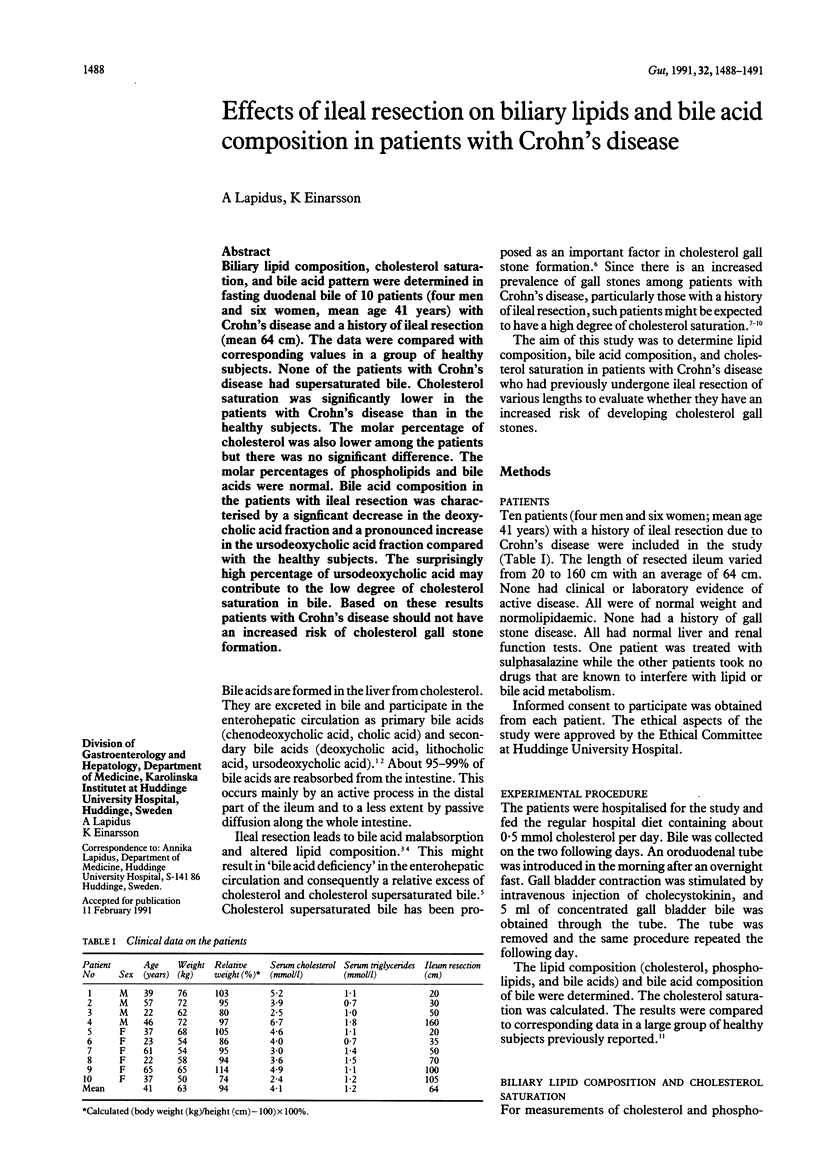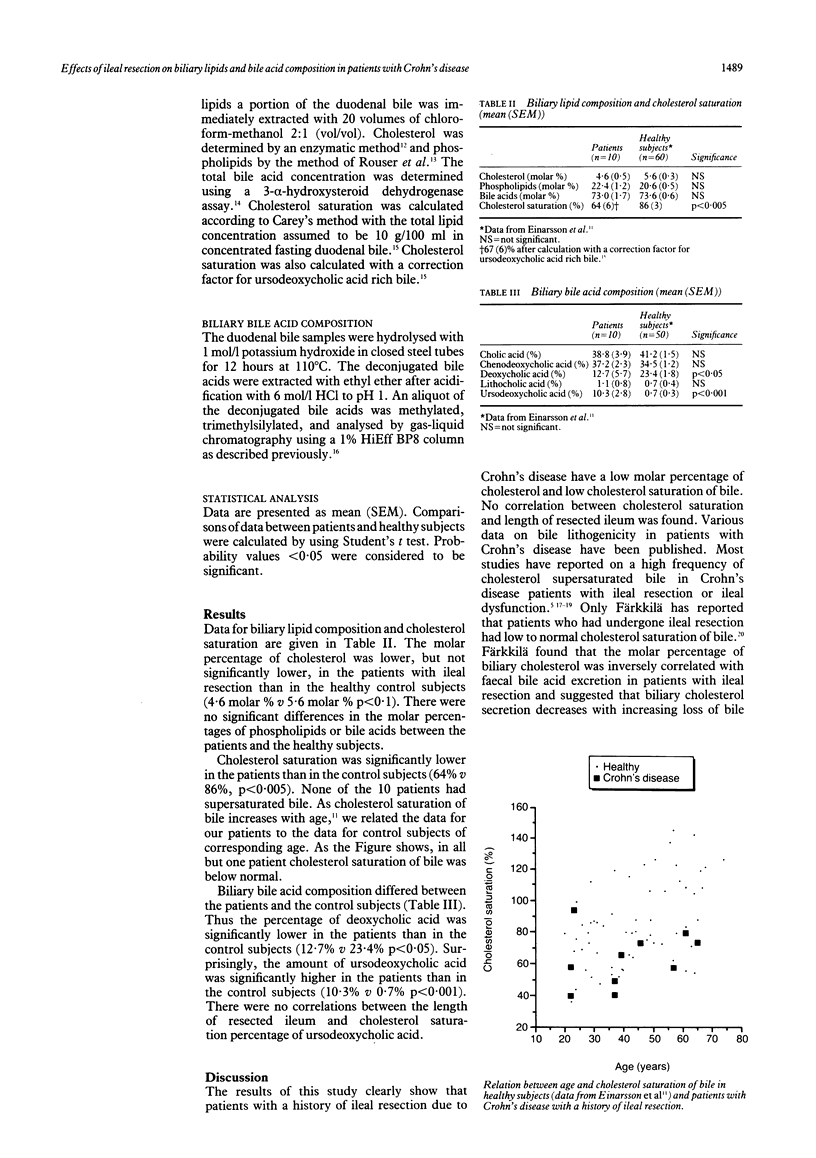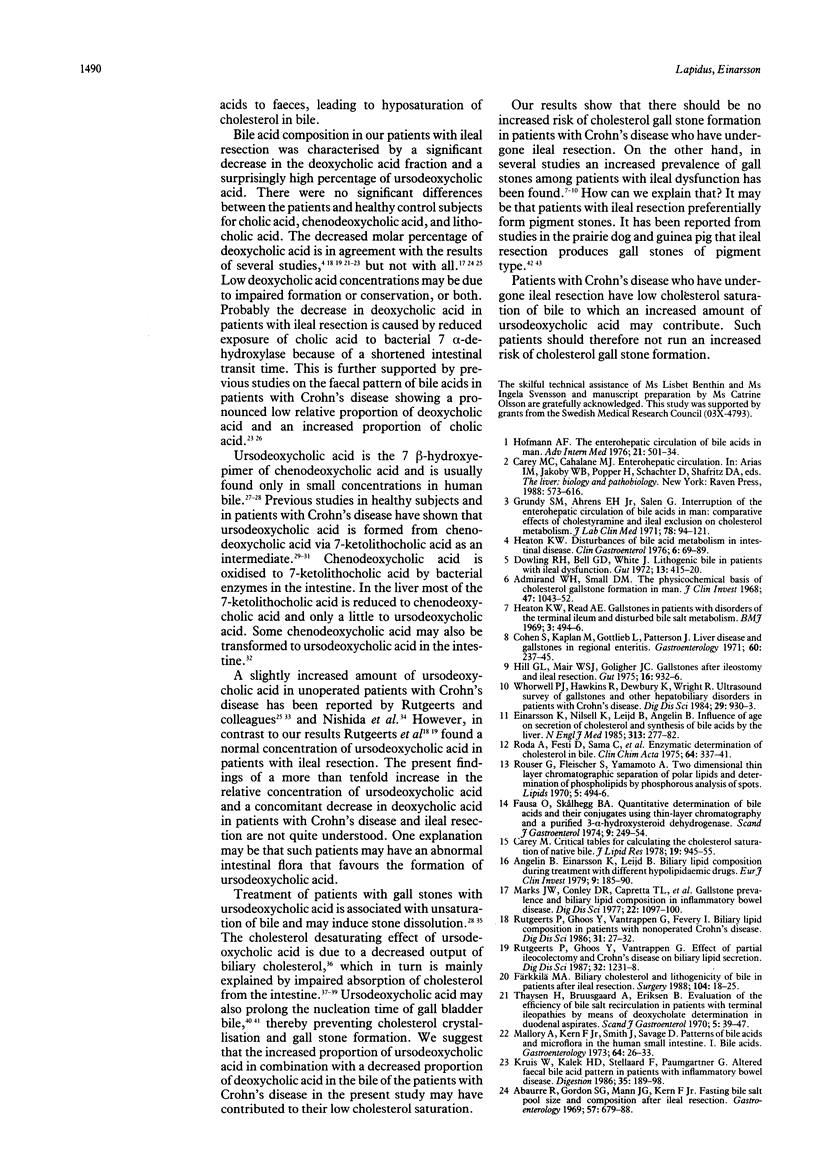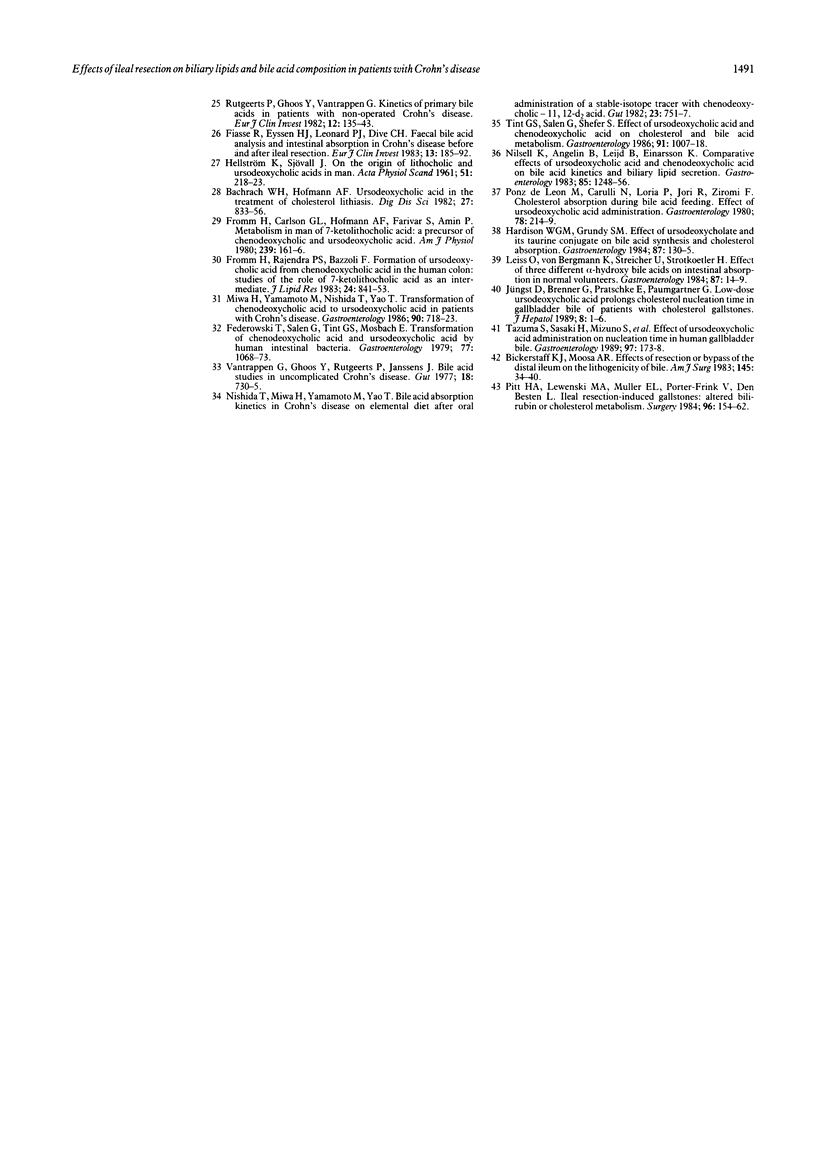Abstract
Biliary lipid composition, cholesterol saturation, and bile acid pattern were determined in fasting duodenal bile of 10 patients (four men and six women, mean age 41 years) with Crohn's disease and a history of ileal resection (mean 64 cm). The data were compared with corresponding values in a group of healthy subjects. None of the patients with Crohn's disease had supersaturated bile. Cholesterol saturation was significantly lower in the patients with Crohn's disease than in the healthy subjects. The molar percentage of cholesterol was also lower among the patients but there was no significant difference. The molar percentages of phospholipids and bile acids were normal. Bile acid composition in the patients with ileal resection was characterised by a significant decrease in the deoxycholic acid fraction and a pronounced increase in the ursodeoxycholic acid fraction compared with the healthy subjects. The surprisingly high percentage of ursodeoxycholic acid may contribute to the low degree of cholesterol saturation in bile. Based on these results patients with Crohn's disease should not have an increased risk of cholesterol gall stone formation.
Full text
PDF



Selected References
These references are in PubMed. This may not be the complete list of references from this article.
- Abaurre R., Gordon S. G., Mann J. G., Kern F., Jr Fasting bile salt pool size and composition after ileal resection. Gastroenterology. 1969 Dec;57(6):679–688. [PubMed] [Google Scholar]
- Admirand W. H., Small D. M. The physicochemical basis of cholesterol gallstone formation in man. J Clin Invest. 1968 May;47(5):1043–1052. doi: 10.1172/JCI105794. [DOI] [PMC free article] [PubMed] [Google Scholar]
- Angelin B., Einarsson K., Leijd B. Biliary lipid composition during treatment with different hypolipidaemic drugs. Eur J Clin Invest. 1979 Jun;9(3):185–190. doi: 10.1111/j.1365-2362.1979.tb00921.x. [DOI] [PubMed] [Google Scholar]
- Bachrach W. H., Hofmann A. F. Ursodeoxycholic acid in the treatment of cholesterol cholelithiasis. Part II. Dig Dis Sci. 1982 Sep;27(9):833–856. doi: 10.1007/BF01391378. [DOI] [PubMed] [Google Scholar]
- Bickerstaff K. I., Moossa A. R. Effects of resection or bypass of the distal ileum on the lithogenicity of bile. Am J Surg. 1983 Jan;145(1):34–40. doi: 10.1016/0002-9610(83)90163-0. [DOI] [PubMed] [Google Scholar]
- Carey M. C. Critical tables for calculating the cholesterol saturation of native bile. J Lipid Res. 1978 Nov;19(8):945–955. [PubMed] [Google Scholar]
- Cohen S., Kpplan M., Gottlieb L., Patterson J. Liver disease and gallstones in regional enteritis. Gastroenterology. 1971 Feb;60(2):237–245. [PubMed] [Google Scholar]
- Dowling R. H., Bell G. D., White J. Lithogenic bile in patients with ileal dysfunction. Gut. 1972 Jun;13(6):415–420. doi: 10.1136/gut.13.6.415. [DOI] [PMC free article] [PubMed] [Google Scholar]
- Einarsson K., Nilsell K., Leijd B., Angelin B. Influence of age on secretion of cholesterol and synthesis of bile acids by the liver. N Engl J Med. 1985 Aug 1;313(5):277–282. doi: 10.1056/NEJM198508013130501. [DOI] [PubMed] [Google Scholar]
- Fausa O., Skålhegg B. A. Quantitative determination of bile acids and their conjugates using thin-layer chromatography and a purified 3alpha-hydroxysteroid dehydrogenase. Scand J Gastroenterol. 1974;9(3):249–254. [PubMed] [Google Scholar]
- Fedorowski T., Salen G., Tint G. S., Mosbach E. Transformation of chenodeoxycholic acid and ursodeoxycholic acid by human intestinal bacteria. Gastroenterology. 1979 Nov;77(5):1068–1073. [PubMed] [Google Scholar]
- Fiasse R., Eyssen H. J., Leonard J. P., Dive C. Faecal bile acid analysis and intestinal absorption in Crohn's disease before and after ileal resection. Eur J Clin Invest. 1983 Jun;13(3):185–192. doi: 10.1111/j.1365-2362.1983.tb00086.x. [DOI] [PubMed] [Google Scholar]
- Fromm H., Sarva R. P., Bazzoli F. Formation of ursodeoxycholic acid from chenodeoxycholic acid in the human colon: studies of the role of 7-ketolithocholic acid as an intermediate. J Lipid Res. 1983 Jul;24(7):841–853. [PubMed] [Google Scholar]
- Färkkilä M. A. Biliary cholesterol and lithogeneity of bile in patients after ileal resection. Surgery. 1988 Jul;104(1):18–25. [PubMed] [Google Scholar]
- Grundy S. M., Ahrens E. H., Jr, Salen G. Interruption of the enterohepatic circulation of bile acids in man: comparative effects of cholestyramine and ileal exclusion on cholesterol metabolism. J Lab Clin Med. 1971 Jul;78(1):94–121. [PubMed] [Google Scholar]
- HELLSTROM K., SJOVALL J. On the origin of lithocholic and ursodeoxycholic acids in man. Bile acids and steroids 106. Acta Physiol Scand. 1961 Feb-Mar;51:218–223. doi: 10.1111/j.1748-1716.1961.tb02130.x. [DOI] [PubMed] [Google Scholar]
- Hardison W. G., Grundy S. M. Effect of ursodeoxycholate and its taurine conjugate on bile acid synthesis and cholesterol absorption. Gastroenterology. 1984 Jul;87(1):130–135. [PubMed] [Google Scholar]
- Heaton K. W. Disturbances of bile acid metabolism in intestinal disease. Clin Gastroenterol. 1977 Jan;6(1):69–89. [PubMed] [Google Scholar]
- Heaton K. W., Read A. E. Gall stones in patients with disorders of the terminal ileum and disturbed bile salt metabolism. Br Med J. 1969 Aug 30;3(5669):494–496. doi: 10.1136/bmj.3.5669.494. [DOI] [PMC free article] [PubMed] [Google Scholar]
- Hill G. L., Mair W. S., Goligher J. C. Gallstones after ileostomy and ileal resection. Gut. 1975 Dec;16(12):932–936. doi: 10.1136/gut.16.12.932. [DOI] [PMC free article] [PubMed] [Google Scholar]
- Hofmann A. F. The enterohepatic circulation of bile acids in man. Adv Intern Med. 1976;21:501–534. [PubMed] [Google Scholar]
- Jüngst D., Brenner G., Pratschke E., Paumgartner G. Low-dose ursodeoxycholic acid prolongs cholesterol nucleation time in gallbladder bile of patients with cholesterol gallstones. J Hepatol. 1989 Jan;8(1):1–6. doi: 10.1016/0168-8278(89)90154-2. [DOI] [PubMed] [Google Scholar]
- Kruis W., Kalek H. D., Stellaard F., Paumgartner G. Altered fecal bile acid pattern in patients with inflammatory bowel disease. Digestion. 1986;35(4):189–198. doi: 10.1159/000199367. [DOI] [PubMed] [Google Scholar]
- Mallory A., Kern F., Jr, Smith J., Savage D. Patterns of bile acids and microflora in the human small intestine. I. Bile acids. Gastroenterology. 1973 Jan;64(1):26–33. [PubMed] [Google Scholar]
- Marks J. W., Conley D. R., Capretta T. L., Bonorris G. G., Chung A., Coyne M. J., Schoenfield L. J. Gallstone prevalence and biliary lipid composition in inflammatory bowel disease. Am J Dig Dis. 1977 Dec;22(12):1097–1100. doi: 10.1007/BF01072864. [DOI] [PubMed] [Google Scholar]
- Miwa H., Yamamoto M., Nishida T., Yao T. Transformation of chenodeoxycholic acid to ursodeoxycholic acid in patients with Crohn's disease. Gastroenterology. 1986 Mar;90(3):718–723. doi: 10.1016/0016-5085(86)91128-5. [DOI] [PubMed] [Google Scholar]
- Nilsell K., Angelin B., Leijd B., Einarsson K. Comparative effects of ursodeoxycholic acid and chenodeoxycholic acid on bile acid kinetics and biliary lipid secretion in humans. Evidence for different modes of action on bile acid synthesis. Gastroenterology. 1983 Dec;85(6):1248–1256. [PubMed] [Google Scholar]
- Nishida T., Miwa H., Yamamoto M., Koga T., Yao T. Bile acid absorption kinetics in Crohn's disease on elemental diet after oral administration of a stable-isotope tracer with chenodeoxycholic-11, 12-d2 acid. Gut. 1982 Sep;23(9):751–757. doi: 10.1136/gut.23.9.751. [DOI] [PMC free article] [PubMed] [Google Scholar]
- Pitt H. A., Lewinski M. A., Muller E. L., Porter-Fink V., DenBesten L. Ileal resection-induced gallstones: altered bilirubin or cholesterol metabolism? Surgery. 1984 Aug;96(2):154–162. [PubMed] [Google Scholar]
- Ponz de Leon M., Carulli N., Loria P., Iori R., Zironi F. Cholesterol absorption during bile acid feeding. Effect of ursodeoxycholic acid (UDCA) administration. Gastroenterology. 1980 Feb;78(2):214–219. [PubMed] [Google Scholar]
- Roda A., Festi D., Sama C., Mazzella G., Alini R., Roda E., Barbara L. Enzymatic determination of cholesterol in bile. Clin Chim Acta. 1975 Nov 3;64(3):337–341. doi: 10.1016/0009-8981(75)90364-2. [DOI] [PubMed] [Google Scholar]
- Rouser G., Fkeischer S., Yamamoto A. Two dimensional then layer chromatographic separation of polar lipids and determination of phospholipids by phosphorus analysis of spots. Lipids. 1970 May;5(5):494–496. doi: 10.1007/BF02531316. [DOI] [PubMed] [Google Scholar]
- Rutgeerts P., Ghoos Y., Vantrappen G. Effects of partial ileocolectomy and Crohn's disease on biliary lipid secretion. Dig Dis Sci. 1987 Nov;32(11):1231–1238. doi: 10.1007/BF01296371. [DOI] [PubMed] [Google Scholar]
- Rutgeerts P., Ghoos Y., Vantrappen G., Fevery J. Biliary lipid composition in patients with nonoperated Crohn's disease. Dig Dis Sci. 1986 Jan;31(1):27–32. doi: 10.1007/BF01347906. [DOI] [PubMed] [Google Scholar]
- Rutgeerts P., Ghoos Y., Vantrappen G. Kinetics of primary bile acids in patients with non-operated Crohn's disease. Eur J Clin Invest. 1982 Apr;12(2):135–143. doi: 10.1111/j.1365-2362.1982.tb00950.x. [DOI] [PubMed] [Google Scholar]
- Tazuma S., Sasaki H., Mizuno S., Sagawa H., Hashiba S., Horiuchi I., Kajiyama G. Effect of ursodeoxycholic acid administration on nucleation time in human gallbladder bile. Gastroenterology. 1989 Jul;97(1):173–178. doi: 10.1016/0016-5085(89)91432-7. [DOI] [PubMed] [Google Scholar]
- Thaysen E. H., Bruusgaard A., Eriksen B. Evaluation of the efficiency of bile salt recirculation in patients with terminal ileopathies by means of deoxycholate determination in duodenal aspirates. Scand J Gastroenterol. 1970;5(1):39–47. [PubMed] [Google Scholar]
- Tint G. S., Salen G., Shefer S. Effect of ursodeoxycholic acid and chenodeoxycholic acid on cholesterol and bile acid metabolism. Gastroenterology. 1986 Oct;91(4):1007–1018. doi: 10.1016/0016-5085(86)90708-0. [DOI] [PubMed] [Google Scholar]
- Vantrappen G., Ghoos Y., Rutgeerts P., Janssens J. Bile acid studies in uncomplicated Crohn's disease. Gut. 1977 Sep;18(9):730–735. doi: 10.1136/gut.18.9.730. [DOI] [PMC free article] [PubMed] [Google Scholar]
- Whorwell P. J., Hawkins R., Dewbury K., Wright R. Ultrasound survey of gallstones and other hepatobiliary disorders in patients with Crohn's disease. Dig Dis Sci. 1984 Oct;29(10):930–933. doi: 10.1007/BF01312482. [DOI] [PubMed] [Google Scholar]


